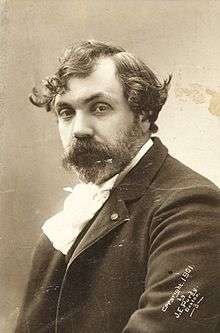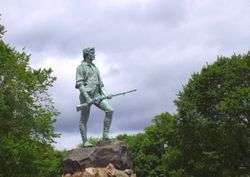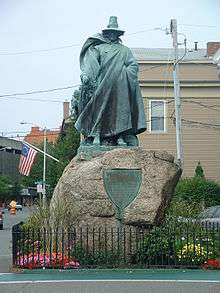Henry Hudson Kitson
| Sir Henry Hudson Kitson | |
|---|---|
 | |
| Born | April 9, 1863 |
| Died | June 26, 1947 (aged 84) |
| Nationality | English |
| Known for | Sculpture |
| Spouse(s) | Theo Alice Ruggles Kitson |
Sir Henry Hudson Kitson (April 9, 1863,[1] 1864 or 1865[2] – June 26, 1947) was an English born American sculptor[3] who sculpted many representations of American military heroes. Often known as H. H. Kitson he was born in Huddersfield, West Yorkshire, England and died at Tyringham, Massachusetts. His knighthood was bestowed upon him by Romania's Queen Elisabeth after he sculpted a marble bust of her in the early 1900s.
His student and first wife, Theo Alice Ruggles Kitson was a sculptor too and his brothers, John William Kitson, Samuel James Kitson, and Robert Lewellen Kitson, also had art careers in the United States.
Life
Harry, as he was known by his numererous brothers and sisters, migrated to the United States about 1877/8 where he apprenticed with his oldest brother John William Kitson. William Kitson was in business with another Englishman Robert Ellin; their firm, Ellin & Kitson, were identified as architectural sculptors. They specialized in interior carving and wood work in commercial structures and churches. Some buildings they worked on were the Equitable Building, the Tilden Mansion, the Astor Memorial Redos and the William K. Vanderbilt House.
Harry and Samuel James Kitson the next oldest brother were both associated with Ellin & Kitson doing sculptural work. According to family oral history, William now quite successful encouraged and financially provided for Harry Kitson to move to Paris 1n 1882 where he studied at the École des Beaux-Arts under the sculptor Jean-Marie Bonnassieux and sculptor Dumont. Kitson also was enrolled in the École nationale supérieure des arts décoratifs studying under Millet and Ganter. He returned first in 1884/5 to NYC to his eldest brother William's business but in 1886 removed to Boston where his sculptor brother Sam had established a studio. Once there Kitson received numerous commissions and began teaching. John William Kitson died in 1888 (see NY Times) and Samuel James had returned to Boston after a stay in Washington DC. The youngest brother Robert Lewellen Kitson a water-colorist joined his older brothers in Boston about 1902.
In 1893, Henry married Theo Alice Ruggles, a former student of his, who went on to have a successful career of her own as Theo Alice Ruggles Kitson. Theo and Harry had three children: Theo (called Babs), John, who became a civil engineer, and Dorothy. None of the children had issue. The noted sculptor Gaston Lachaise worked in his atelier. Many of Henry Hudson Kitson papers are in the Archives of American Art in Washington, D.C. as well as the New York Historical Society. Kitson only carried a British passport.
He was the author of numerous public monuments, and left behind his home, Santarella, in Tyringham. The home, which Kitson modified extensively, was recently restored and now operates as a special events venue as well as providing overnight accommodation.
-

Minute Man Statue, Lexington, Massachusetts
-

Closeup view of Minute Man Statue
-

Roger Conant Statue, Salem, Massachusetts
-

Santarella, Tyringham, Massachusetts
Selected works
- Vicksburg National Military Park has the following works by Kitson. They can be viewed via a National Parks webpage
- Confederate President Jefferson Davis (statue) 1927
- Iowa Monument (six relief panels 1906 and equestrian statue 1912)
- Iowa Governor Samuel J. Kirkwood (bust) 1928
- Union Brig. Gen. Mortimer D. Leggett (relief portrait) 1911
- Confederate Brig. Gen. Stephen D. Lee (statue) 1909 (first chairman of the Vicksburg NMP Commission)
- Union Maj. Gustavus Lightfoot (relief portrait) 1914
- Union Adm. David Glasgow Farragut (statue on Navy Monument) 1917
- Union Lt. William T. Rigby (bust) 1928 (Resident Commissioner of VNMP 1899-1929)
- Union Lt. Cmdr. Thomas O. Selfridge, Jr. (bust) 1913
- Confederate Maj. Gen. Martin L. Smith (bust) 1911
- Boston area
- Nathaniel P. Banks, Waltham, Massachusetts
- David Farragut, Marine Park, South Boston, Massachusetts, 1881
- Minute man statue, Lexington, Massachusetts town green 1900 (often mistaken to be of minuteman Captain John Parker)
- Roger Conant statue at Salem, Massachusetts 1905
- Robert Burns 1920 Back Bay Fens, Boston. Relocated to Winthrop Square, Boston 1975
- Henry B. Endicott tablet, Boston, Massachusetts 1921
- The Pilgrim Maiden statue, Brewster Gardens, Plymouth, Massachusetts 1922
- Sir Richard Saltonstall monument, Watertown, Massachusetts 1931
- Kentucky
References
- ↑ Greenthal. Kozol, Ramirez, ‘’American Figurative Sculpture in the Museum of Fine Arts, Boston’’, Northeastern University Press and the Museam of Fine Arts, Boston., 1986 p. 299, 301
- ↑ Taft, Lorado, ‘’The History of American Sculpture’’, The Macmillan Company, New York,1925 p. 489
- ↑ Greenthal. Kozol, Ramirez, ‘’American Figurative Sculpture in the Museum of Fine Arts, Boston’’, Northeastern University Press and the Museam of Fine Arts, Boston., 1986 p. 300
Family letters, business letters, photos and other documents held by family historian
- Frank Torrey Robinson, "Living New England Artists: Biographical Sketches...", S. E. Cassino, Publisher Boston 1888 pgs 113-119
- Columbia Publishing Company, MA {(Massachusetts Of Today: A Memorial of the State, Historical and Biographical)}, 1892 by Toomey & Juinn, Page 172
External links
- Santarella